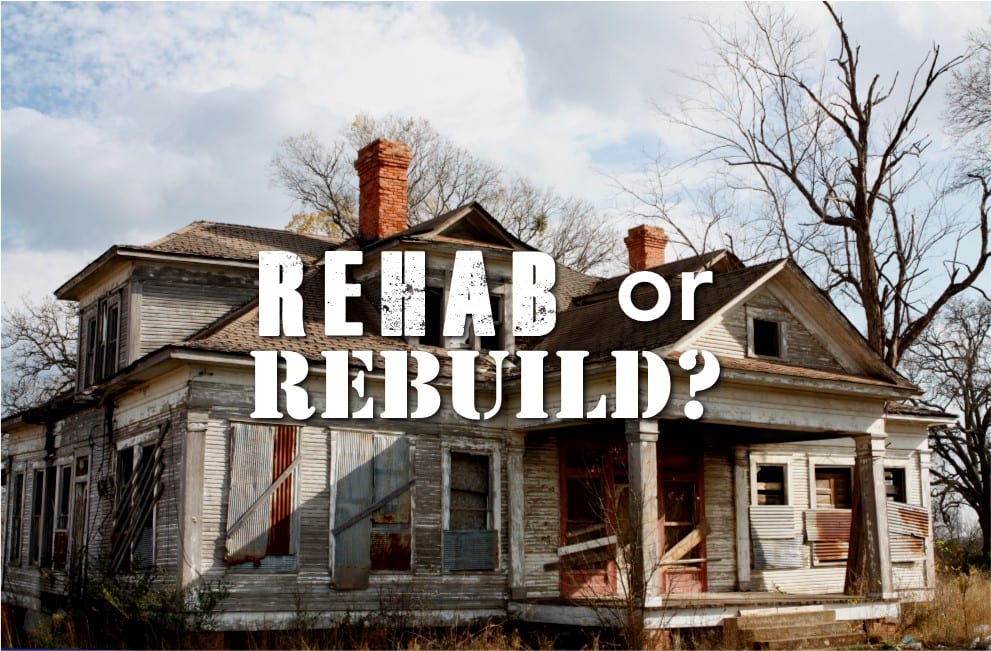If you’ve just bought an investment property that needs a lot of work, you might be wondering if you should fix it up or just tear it down and start over. That is a common occurrence when purchasing a single-family home that has significant damage, leaving you on the fence. This post walks you through how to determine whether a rebuild or a rehab will be the best for your bottom line and the financing options that will work for you.
General Guidelines For When To Rehab Or Rebuild
There are some rules of thumb that you should know when determining if a rehab or rebuild makes more sense.
Consider a Rehab if:
- The floor plan is being changed but there are historical elements that add value to the home worth keeping
- You plan on adding new doors and new windows but will otherwise keep the exterior intact
- Asbestos is present, and encapsulation is more cost-effective than removal
Choose a Rebuild if:
- Multiple structural components like the foundation and roof need replacing
- The footprint of the current structure prevents you from getting your maximum ARV
- Structure has extensive damage from fire or flooding
How to Determine How Much Time And Money Repairs Will Cost
If you know what to looks for, you can usually get a good sense of the scope of work required to bring the property up to resale standards just from a walk-through. Deciding between a rehab or a tear-down and rebuild can be tough when a property is in really rough condition since both options have their own challenges and benefits.
Some issues with rebuilds include:
- New construction permits often cost more than renovation ones and the wait to get approved sometimes takes longer which increases your carrying costs.
- The entire process may need approval from a homeowner’s association including getting an extra set of blueprints for them to review and altering architectural elements to adhere to the HOA’s rules and standards.
- New builds may have to conform to new setback standards affecting the placement of the building, parking, and walkways.
- Extra research is needed to make sure you don’t over-improve for the neighborhood and end up losing money on your new structure.
Going with a rehab can also be tricky.
- Once you open things up, you could find unexpected issues that must be addressed and eat away at your profits.
- Replacing the plumbing or electrical takes more time and effort when you have to run them through existing walls.
- Foundation settling and sagging can make walls and floors uneven making it hard to install new drywall, cabinets, or trim in a straight line.
- Older homes might not fit standard sized doors, windows or other materials meaning you’ll have to replace the whole thing or custom order one to specific dimensions.
If you’re stuck, look for someone who’s been through the process before, perhaps a general contractor with experience on the same block, or another investor who can provide some guidance. You can also talk to your hard money lender and see if they’ve offered loans nearby and what problems they’ve seen or construction issues that have come up. They are always a great resource since they have dealt with a variety of projects with different concerns and have likely financed a property down the street.
The Best Financing Options for Rehabbing or Rebuilding a Single-Family Home
If you don’t plan to use your own cash, you need to determine which loan makes the most sense for your project; and this affects whether you choose a rehab or rebuild for a single-family home. It’s crucial to know how long permitting and construction will take so you can estimate your carrying costs. You also need to know how much money you can bring to the transaction to secure a loan with a desirable rate. Here are some of the more popular loan options and when they may make sense for investors.
- Acquisition-only Loan – This type of financing is perfect if you need to buy the property but plan to cover all of the construction costs out of pocket. A loan may cover up to 65% LTV with no prepayment penalty.
- Fix and Flip Loan – This is a short-term loan for a few months up to a year that provides money toward acquisition as well as 100% of the construction costs for your rehab, as long as they have been properly defined ahead of time.
- New Construction Loan – This is a 12-month loan for teardowns and infills when you’re building a new structure on an existing lot but need to finance the construction costs as well as the acquisition.
When you’re considering investing in a single-family home, carefully weigh your options. If you find yourself stuck in deciding whether to rehab or rebuild, talk to your lender. There’s a good chance they have the exact experience you’re looking for and they can help you make the best decision for your flipping business.

